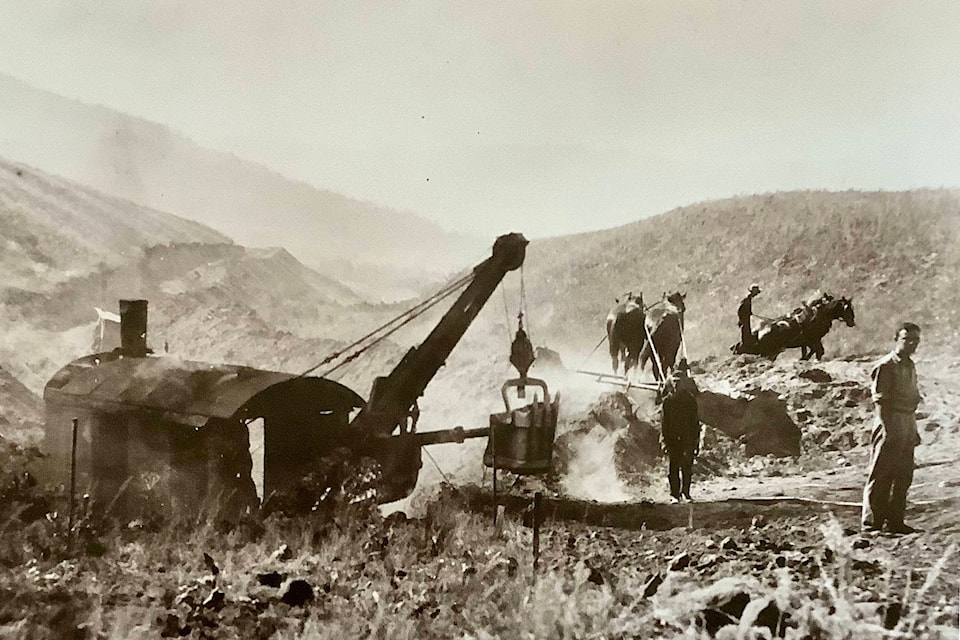Every day hundreds of people walk, jog or cycle sections of the Grey Canal’s scenic trails that surround Vernon and the Coldstream Valley.
But who remembers when water flowed from the hills through the Grey Canal’s gravity-fed open ditches, wooden flumes and pipes to supply farms and orchards with irrigation up until 50 years ago? How many marvel at the incredible engineering feat of its day?
Let’s look back into the history of this area.
For thousands of years, the original Okanagan First Nations people always chose areas near creeks, lakes or other water sources for their seasonal encampments. By the 1860s, Cornelius O’Keefe, Francis Barnard (BX Ranch) and a few other enterprising young men from Eastern Canada, Britain and Europe, acquired land in the North Okanagan and grew rich by ranching to feed the hungry Cariboo gold rush miners around Barkerville.
Thousands of cattle free-ranged the tall, lush bunchgrasses of the dry hillsides. These ranchers also settled by good water sources.
Once the goldfields dwindled away by the 1890s, new settlers were attracted to the warm, scenic Okanagan Valley. Land developers, inspired by Lord and Lady Aberdeen’s Coldstream orchards and ranch, subdivided the large ranchlands into orchard estates complete with fruit trees. But the new settlers, mostly British and Belgian aristocracy, were unfamiliar with orchards. They soon realized that more water was required for the fruit trees and demanded an irrigation system.
So in 1906, the land developers began an incredibly extensive engineering feat – an irrigation canal system that would encircle 30 miles (50 km) around Coldstream and the North Okanagan’s growing new city of Vernon. It ran from the hills above Lavington to Okanagan Lake encircling the BX, Swan Lake and Bella Vista and took until 1914 to complete. It was the largest single irrigation system in B.C.’s history. Earl Grey, the Governor General of Canada 1904-11, visited the newly constructed headgates and intake of the Lavington section in 1907 and named it the Grey Canal.
Dozens of men with horse-drawn slip scrapers ploughed the extensive wide open ditch canal.
Later a steam shovel and then another was added to speed up the process. Parts of the canal were reinforced with wood stave flumes and wire-wrapped wood siphon pipes were added to flow water through draws.
Technology for the wooden flumes and siphons came from European wine-barrels.
Irrigation water usually ran from June to October. But water loss through continual seepage, evaporation, breaks, droughts and even floods created havoc.
The canal’s expensive construction, along with ongoing repair and maintenance costs, pushed the land developers into bankruptcy. A public utility was formed – the Vernon Irrigation District (VID) in 1920 to take over.
VID kept maintaining, repairing and running the canal until metal water pipes were invented and a buried pipe system replaced the canal by 1970. Once the canal dried up, it became a natural, level walking path with spectacular valley views.
Vernon’s Ribbons of Green Trail Society has been lobbying and advocating to acquire the whole Grey Canal system for a continual trail. Check out their website ribbonsofgreen.ca for the best directions and information on the Grey Canal Trail sections.
You can see the impressive last remaining flumes and trestles on the Swan Lake East section near Glen Hayes Road. And interesting interpretive signs on the Foothills trail section and north of McLennan Road have wonderful historic photos.
Water From The Hills by Peter Tassie is an amazingly detailed history of the Grey Canal with fabulous historic photos and maps. It’s available from the museum and library.
Roseanne enthusiastically shares her knowledge of the outdoors to help readers experience and enjoy nature. Discover exciting and adventurous natural events, best trails, and wild places. Follow her on Facebook for more.
